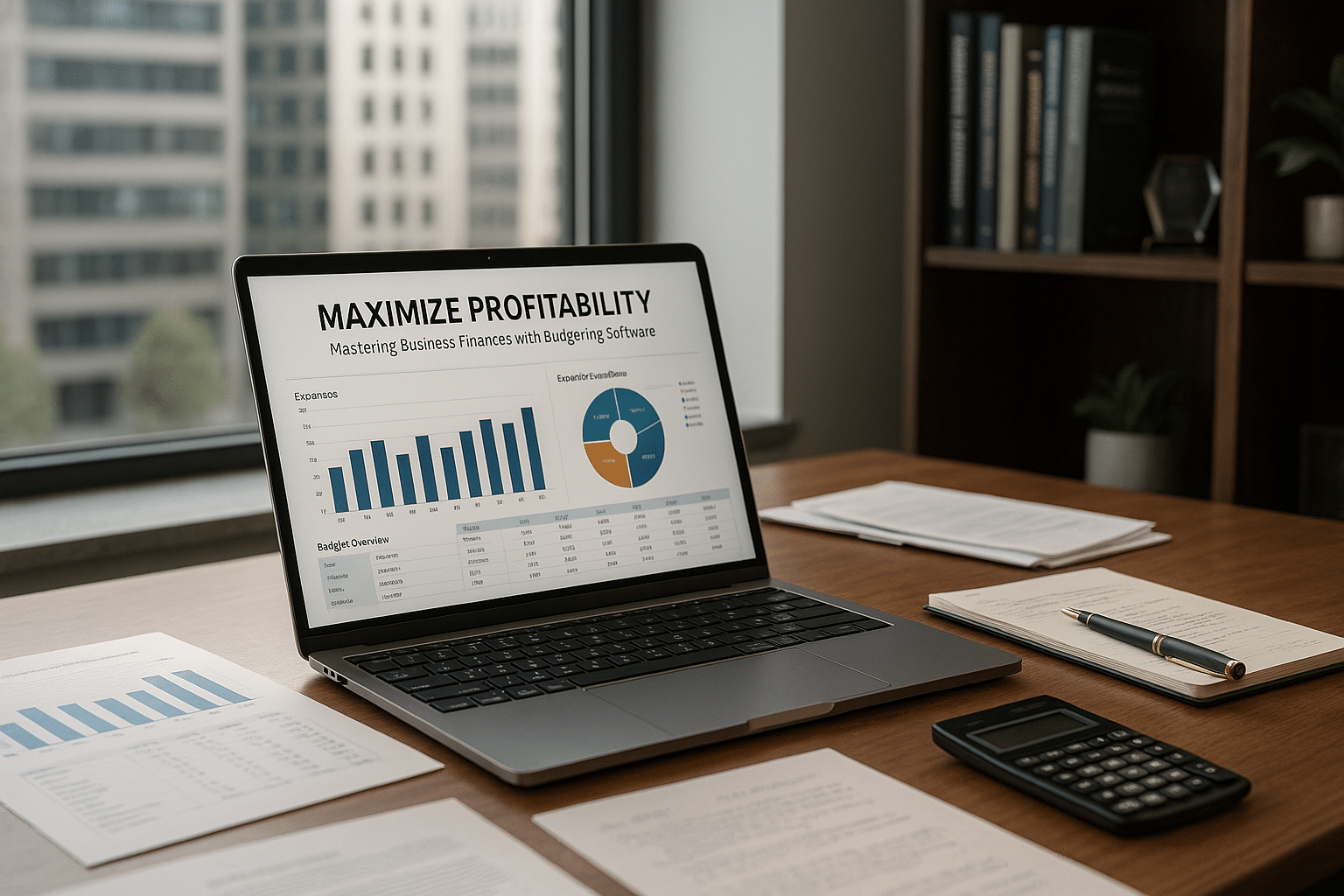If you’re wrestling with managing your company’s finances, one of the most impactful solutions is budgeting software 🖥️. In this article, we will delve deep into the nitty-gritty of how this software can help you master your business finances and optimize profitability.
From balancing the books to formulating lucrative financial forecasts, managing business finances is no small feat. It requires a fine blend of analytical thinking, strategic planning, and relentless dedication. But here’s the good news: modern technology, particularly budgeting software, can make these tasks significantly more manageable and efficient.
But before we jump into the details, let’s understand what budgeting software actually is. Essentially, it’s a digital tool that helps businesses plan, manage, and track their financial resources. It enables you to create detailed budget plans, monitor spending, analyze financial trends, and make well-informed financial decisions 📊. This kind of software can help you stay on top of your finances, streamline processes, and ultimately, boost your bottom line.
What to Expect
In the ensuing sections, we will journey together through the intricacies of budgeting software. We will uncover the benefits it brings to businesses, elucidate on how it works, and explore how it can catalyze your journey towards increased profitability 💰. We will also provide a practical guide on how to choose the best budgeting software that fits your business needs.
Moreover, this article will shed light on some real-world case studies, demonstrating how budgeting software has transformed the financial management of businesses across diverse sectors. By the end of this piece, you should be well-equipped with a robust understanding of budgeting software, and hopefully, a clear path forward to leveraging this tool for your own business’s financial success.
Are you ready?
If you’re ready to harness the power of technology for your financial management, then buckle up for a deep dive into the world of budgeting software! Whether you’re a seasoned finance professional or a small business owner looking to gain a better handle on your finances, this article promises valuable insights and actionable advice 💡. Let’s embark on this enlightening journey towards mastering your business finances and maximizing your profitability with budgeting software!
Remember, the future of business is digital. And with the right tools and understanding, you can revolutionize your business finances, increase efficiency, and see a significant uptick in your profitability. So, let’s get started!
Unlocking the Power of Budgeting Software
Business finances are a complex maze of numbers, spreadsheets, and meticulous calculations. Navigating this landscape can be daunting, especially without the right tools. This is where budgeting software steps in. When harnessed correctly, budgeting software can optimize financial processes, drive growth, and ultimately, maximize profitability.
According to a report from Grand View Research, the global budgeting software market size was valued at USD 3.96 billion in 2019 and is expected to grow at a compound annual growth rate (CAGR) of 14.0% from 2020 to 2027. This points to a growing reliance on these digital solutions, an indication of their value in managing business finances.
Whether you’re a seasoned business owner or just starting, understanding how to leverage budgeting software can significantly enhance your financial management. But how exactly can these digital tools impact your bottom line? Let’s delve in.
The Role of Budgeting Software in Business Finance
Budgeting software, in essence, automates and streamlines the process of planning, coordinating, recording, and analyzing a business’s financial activities. It’s an all-encompassing tool that handles everything from expense tracking to forecasting future financial trends.
One crucial benefit of these platforms is their ability to foster efficiency. They eliminate manual data entry, reduce the risk of human error, and save time. This newfound efficiency can be redirected towards strategizing and making data-driven financial decisions.
Watch the video below from the channel ‘Software Advice’ titled “What Is Budgeting Software?” for a comprehensive understanding of how budgeting software works.
Driving Profitability with Budgeting Software: A Deep Dive
Maximizing profitability isn’t just about increasing sales; it’s about managing costs, streamlining operations, and making informed financial decisions. Here’s how budgeting software can play a pivotal role in these areas.
1. Cost Management
Effective cost management is a key factor in maximizing profitability. Budgeting software provides a clear picture of your spending patterns, enabling you to identify areas of wastage and potential savings. By tracking every dollar, these tools ensure that all expenses align with your strategic goals, preventing unnecessary costs from eroding your profits.
2. Data-driven Decision Making
Budgeting software facilitates data-driven decision making by providing real-time, accurate financial data. This information can guide strategies, investments, and operational changes. The ability to make quick, informed decisions based on solid data can significantly boost profitability.
3. Forecasting and Planning
Forecasting is a critical aspect of financial management. It involves predicting future revenue, expenses, and cash flow based on historical data. With budgeting software, businesses can generate accurate forecasts that guide financial planning and decision-making. This proactive approach to finances can minimize risk and maximize profitability.
Choosing the Right Budgeting Software: Key Factors to Consider
With a myriad of budgeting software solutions available in the market, finding the perfect fit for your business can be a challenge. However, understanding your needs and considering specific factors can simplify this process.
1. Usability
Usability is a crucial factor to consider when choosing budgeting software. The platform should be user-friendly and easy to navigate, reducing the learning curve for your team. Look for intuitive interfaces, clear instructions, and responsive customer support.
2. Integration Capabilities
The software should integrate seamlessly with your existing systems, such as your accounting software or ERP system. This ensures a smooth flow of data between platforms, improving accuracy and efficiency.
3. Customization
Every business is unique, and so are its financial management needs. Therefore, a one-size-fits-all approach won’t cut it. The budgeting software you choose should offer customization options to cater to your specific requirements.
Consider the table below, comparing key features of popular budgeting software solutions:
| Software | Usability | Integration Capabilities | Customization |
|---|---|---|---|
| Software A | High | High | Medium |
| Software B | Medium | Medium | High |
| Software C | High | High | High |
Budgeting software is more than just a financial tool; it’s a strategic asset that can significantly enhance your profitability. Harnessing its power requires understanding its capabilities and aligning them with your business needs. The journey may seem complex, but the potential rewards make it well worth the effort.

Conclusion
In conclusion, we have navigated through an extensive discourse on a topic that intersects technology and engineering, unearthing layers of knowledge and generating practical insights. The core essence of this article resonates with the ever-evolving dynamics of the Information Technology and Engineering sectors, illustrating their intricate interplay and dependence.
To summarize, we delved into the underlying principles of our subject matter, establishing its foundational background and exploring its wider ramifications in a digital age. We then segued into the pragmatic applications and the significance they hold in real-world scenarios. The multifaceted role played by these principles, in both the realms of software development and overall business operations, was meticulously examined, painting a comprehensive picture of the subject’s omnipresence in our daily lives.
The ability to grasp such intricate topics, breaking them down into simpler terms, is a skill that becomes even more valuable in an era where technological literacy is no longer a luxury, but a necessity. The importance of understanding the principles explored in this article cannot be overstated – they are the building blocks of modern technological landscapes and the fuel driving innovation in multiple industries.
This discourse aimed to be not only informative but also engaging, presenting complex ideas in an accessible and reader-friendly manner. It is my hope that the article has inspired you to further explore these topics, either out of personal curiosity or to enhance your professional competence.
So, what’s next? This article only scratches the surface. There’s always more to learn and unchartered territories to explore. Don’t let the journey stop here. I encourage you to delve deeper, take the initiative to research, share your thoughts, engage in conversations and be a part of this vast, fascinating world of technology and engineering.
📚 ResearchGate, JSTOR, and IEEE Xplore are some of the active online platforms where you can find plenty of resources on these subjects.
Your feedback and contributions are not only welcome, but crucial in this quest for knowledge. Leave a comment below or share this article on your social media platforms. Let’s stimulate thoughtful discussions and create a dynamic community of enthusiastic learners. The power to shape the future of technology and engineering is in your hands.
As Benjamin Franklin once said, “An investment in knowledge pays the best interest.” The more we know, the better we can innovate and create. So, let’s keep learning and evolving, with every article, every discussion, and every shared insight.
Until next time, happy reading and happy learning! 😊



